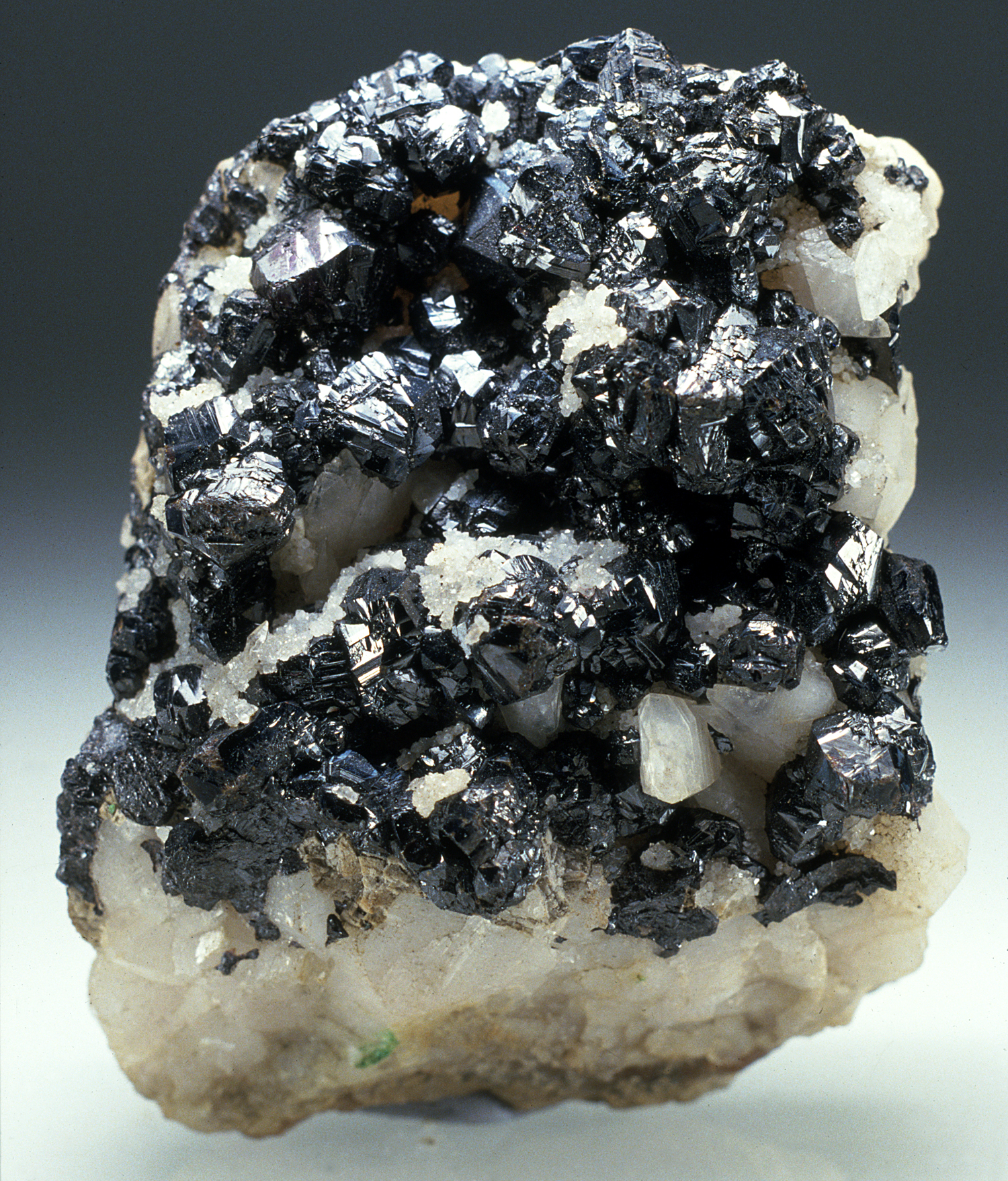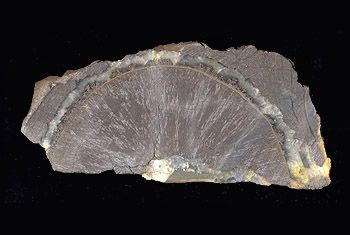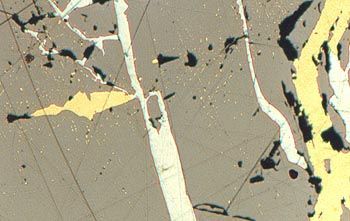Mineral Database (Saesneg yn unig)
Sphalerite
Crystal System: Cubic
Formula: ZnS
Status of Occurrence: Confirmed Occurrence
Distribution: Widespread
Chemical Composition: Zinc sulphide
Method(s) of Verification: all occurrences listed - visually or optically



Chemical Group:
- Sulphides
Geological Context:
- Hydrothermal : Mississippi Valley Type veins
- Hydrothermal : mesothermal polymetallic veins
- Hydrothermal : volcanogenic massive sulphides
- Hydrothermal : sedimentary exhalative deposits
Introduction: sphalerite is one of the commonest sulphides, occurring in a wide range of hydrothermal mineral deposits formed in various geological settings. It is best-known, however, from two types of ore deposits - firstly Mississippi Valley-type (MVT) vein associations and secondly stratiform carbonate hosted synsedimentary massive sulphide deposits of the type worked in the Irish Midlands. Both types of deposit are formed at relatively low-temperatures, although the occurrence of sphalerite is not restricted to low-temperature deposits: for example it may be present in quantity in some mesothermal gold-lode deposits. The commonest associated minerals in hydrothermal deposits are galena (almost invariably), plus baryte, chalcopyrite, pyrite, marcasite, carbonates, fluorite and quartz. Sphalerite also occurs in sedimentary rocks and in concretions or nodules associated with them.
Occurrence in Wales: sphalerite is widely developed in Wales and was extensively mined as an ore of zinc in many areas. However, unlike copper, lead, gold and silver, zinc metal was not extracted commercially in Europe until about 260 years ago when William and John Champion devised processes to recover the metal firstly from calamine (smithsonite) and then from sphalerite. From then on, sphalerite (also known to miners as 'blende' or 'black Jack') was useful as a zinc ore and was increasingly mined in many areas of Wales, but most notably in the Halkyn-Minera and Llanwrst Orefields of North Wales and in the Central Wales Orefield. In these areas it is so widespread that the orefields are treated as localities.
Well-crystallized specimens are, however, uncommon in most areas, with the exception of the Halkyn-Minera orefield and the coalfield ironstone nodules of South Wales, both of which have produced interesting and aesthetically-pleasing specimens. Sphalerite is usually easily identified from its reddish through brown to black colour, its density and its strong but non-metallic lustre. it contains a range of other elements as impurities, particularly iron (the amount of which may affect its colour) and cadmium, which may be present in sufficient amount to constitute a geohazard in groundwaters or in dust from old mine-tailings.
Key Localities:
- Central Wales Orefield: several generations of sphalerite are present within the 12-stage paragenetic sequence (Mason, 1994, 1997) developed in this formerly important zinc-mining district. Early sphalerite, occurring in association with quartz and ferroan dolomite, is present locally and is often rebrecciated and cemented by later minerals, particularly galena and chalcopyrite. It varies in colour from dark brown through to reddish or even yellow (so-called honey-blende). In polished section it commonly reveals the 'chalcopyrite disease' texture in which numerous small blebs of chalcopyrite occur as inclusions, often in orientated rows. Later sphalerites tend to be inclusion-free and dark brown in colour, sometimes with a fibrous internal structure. These later generations of sphalerite include some abundant occurrences: for example at Frongoch Mine over 50,000 tonnes of sphalerite concentrates were sold during the 19th Century (Jones, 1922). Other significant sphalerite-bearing orebodies were worked at the Van, Brynyrafr, Nantycreiau and Cwmystwyth mines. Well-formed sphalerite crystals are rare in Central Wales and no notable specimens are known. In geochemical terms, sphalerite is a potential geohazard in Central Wales: cadmium is commonly present and weathered sphalerite specimens may, upon breaking, reveal thin films of bright yellow cadmium sulphide. On the topic of impurities, an account has been published (Scutt, 1926) of a germanium-rich sphalerite from a mine 'near Devil's Bridge' - unfortunately the precise locality was not stated.
- Dolgellau Gold-belt, Gwynedd: the mesothermal gold-lodes of this area carry locally abundant sphalerite, which is late in the paragenesis (Mason et al., 2002) and replaces earlier minerals. For example, at Gwynfynydd Mine, sphalerite encloses and replaces galena-gold intergrowths, resulting in some very rich specimens (National Museum of Wales Collection). Most of the sphalerite has recrystallized into equigranular masses, with inclusion-forming phases (chalcopyrite and pyrrhotite) concentrated around grain margins. A relatively minor generation of sphalerite is also present as exsolution bodies in chalcopyrite. This is of importance as it is diagnostic of relatively high temperatures of chalcopyrite formation: high-temperature chalcopyrites can carry significant zinc in the lattice structure which exsolves out upon cooling to form sphalerite. Finally, sphalerite also occurs in a crustiform-banded assemblage dominated by layered calcite and marcasite which occupies post-Caledonian fractures crosscutting the gold-lodes.
- Halkyn-Minera district, NE Wales: sphalerite is widespread in the MVT mineral veins that occur in the Carboniferous Limestone of this important mining district (Smith, 1921), although a lot of near-surface occurrences show partial to total oxidation to smithsonite. Sphalerites from this orefield tend to be reddish in colour although they still contain impurities, including cadmium as evidenced by the occurrence of yellow, cadmium-tinted smithsonite occurrences derived from their weathering. Substantial amounts were found in some areas: for example, the Minera Mine produced >1000 tons of zinc concentrates annually right through from 1864 to 1908, with a peak production of 7462 tons in 1887 (Burt et al., 1992). Some excellent specimens, with lustrous reddish to brown sphalerite crystals to over 1 cm associated with quartz and calcite, were produced from the Minera mines and in the Halkyn district the Moel-y-Crio Mine deserves a mention for plates of reddish to orange-brown sphalerite crystals associated with complex twinned galena and calcite (National Museum of Wales specimens, acquired in 1927 from the collection of G.J. Williams).
- Llanrwst Orefield, Gwynedd: this mining district produced approximately equal amounts of lead and zinc metal, according to production figures (Haggerty, 1995). Sphalerite occurs commonly and overgrows galena: it rarely contains chalcopyrite inclusions. Small crystals are present on some of the mine-tips, for example at New Pandora Mine (National Museum of Wales specimens).
- Parys Mountain, Anglesey: sphalerite is an abundant component of the 'bluestone' ore at this locality. Two generations have been identified (Pointon & Ixer, 1980) - the first crowded with chalcopyrite inclusions, the second inclusion-free. Associated minerals are pyrite, chalcopyrite and galena. The presence of significant sphalerite deposits drove much of the recent exploration at the site.
- Snowdon, Gwynedd: sphalerite, sometimes of a distinctive yellow-orange colour, is common on mine-tips within the Snowdon Caldera, especially at the Lliwedd and Drws-y-Coed mines. Only the more brown, iron-rich sphalerite carries chalcopyrite inclusions: the paler varieties are inclusion-free (Reedman et al., 1985). Associated minerals include chalcopyrite, pyrrhotite, galena, pyrite and arsenopyrite.
- South Wales: reddish to yellowish-brown sphalerite occurs widely in the South Wales Pb-Zn Orefield usually as small amounts in MVT mineral veins cutting the Carboniferous Limestone and the overlying Triassic Dolomitic Conglomerate in this area. It is particularly evident in the Llantrisant (Bowler & Kingston, 1971) and Machen areas, though at the latter is widely oxidized to smithsonite and hemimorphite, as seen at Machen Quarry.
- South Wales Coalfield: sphalerite is frequently found accompanying millerite, siegenite, galena and other minerals in septarian clay-ironstone nodules on coal-tips. Some particularly noteworthy specimens were collected in recent years from the Coed Ely Colliery, near Llantrisant (Ian Jones Collection).
References:
- Mineralisation in the Triassic rocks of the Llantrisant area, Glamorgan. 1970 Gregynog Mineral Exploitation Colloquium Report. University College Cardiff, 30-34.
- The Mineral Statistics of the United Kingdom 1845-1913, he Mines of Flintshire and Denbighshire Volume 10, University of Exeter Press, 167pp.
- The Mineralization of the Llanrwst Orefield, North Wales. UK Journal of Mines and Minerals, 15, 5-10.
- Lead and zinc. The mining district of North Cardiganshire and West Montgomeryshire. Memoirs of the Geological Survey. Special Report of the Mineral Resources of Great Britain, 20.
- A Regional Paragenesis for the Central Wales Orefield. Unpublished M.Phil thesis, University of Wales (Aberystwyth).
- Regional polyphase and polymetallic vein mineralisation in the Caledonides of the Central Wales Orefield. Transactions of the Institution of Mining and Metallurgy (Section B: Applied Earth Science), 106, B135-B144.
- Ore Mineralogy of the mesothermal gold lodes of the Dolgellau Gold Belt, North Wales. Transactions of the Institution of Mining and Metallurgy (Section B, Applied earth science), 111, B203-B214.
- Parys Mountain mineral deposit, Anglesey, Wales: geology and ore mineralogy. Transactions of the Institution of Mining and Metallurgy (Section B: Applied earth science), 89, B143-B155.
- Volcanogenic mineralization related to the Snowdon Volcanic Group (Ordovician), Gwynedd, North Wales. Journal of the Geological Society, London, 142, 875-888.
- Lead and zinc ores in the Carboniferous rocks of North Wales. Memoirs of the Geological Survey. Special Report of the Mineral Resources of Great Britain, 19.
